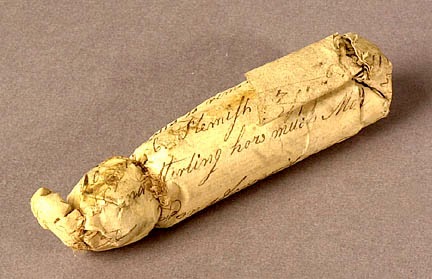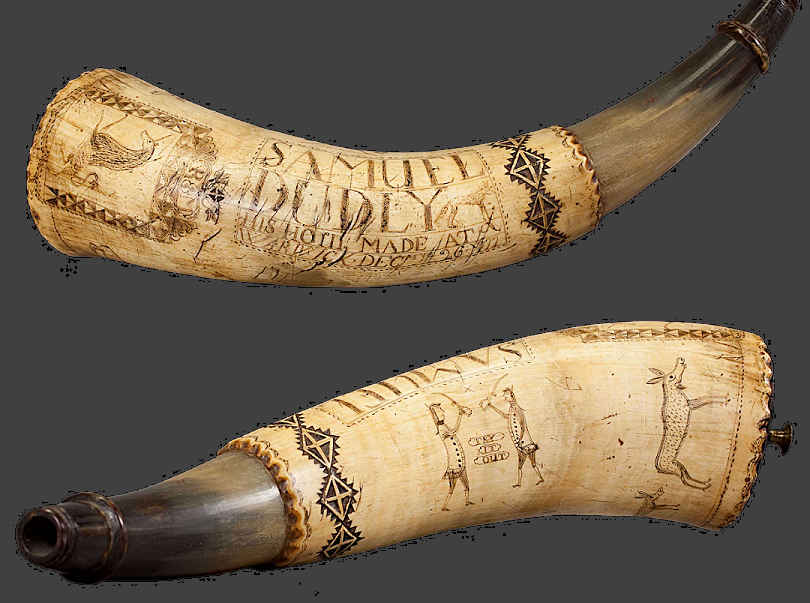Keep Your Powder Dry Ep. 2 - Fort Friday
In part one of Keep
Your Powder Dry we briefly explored the artistic aspects of powder horns
and how they portrayed the Fort Hunter area in the colonial era. A small disclaimer at the bottom of that
article mentions that horns were used to store bulk powder. This article will take a quick look at that
concept of bulk powder as it translates to ammunition cartridges and use.
 Recently another blog – Journal
of the American Revolution covered severe supply shortages in powder the
army needed to be an effective fighting force; especially early in the war
before heavy foreign support. Commentary
on that
post by scholars and authors does a great job in demonstrating bulk powder
stored in barrels and how that translates into rounds of ammunition per pound
and per soldier. For each round the dry
weight measurement of grains is used, and the number of approximate grains per
pound averages at seven thousand. There is some uncertainty as to the number of pounds
per barrel but the common accepted number of rounds that could be produced
from it is around 3,500. That roughly
indicates an average of 40 rounds per pound, assuming that the barrel contains
about 90lbs of powder. Each round would
contain somewhere over 160gr to 220gr that was typically to be used to propel a
.69cal ball from a .75cal musket.
Recently another blog – Journal
of the American Revolution covered severe supply shortages in powder the
army needed to be an effective fighting force; especially early in the war
before heavy foreign support. Commentary
on that
post by scholars and authors does a great job in demonstrating bulk powder
stored in barrels and how that translates into rounds of ammunition per pound
and per soldier. For each round the dry
weight measurement of grains is used, and the number of approximate grains per
pound averages at seven thousand. There is some uncertainty as to the number of pounds
per barrel but the common accepted number of rounds that could be produced
from it is around 3,500. That roughly
indicates an average of 40 rounds per pound, assuming that the barrel contains
about 90lbs of powder. Each round would
contain somewhere over 160gr to 220gr that was typically to be used to propel a
.69cal ball from a .75cal musket.
The math can seem overwhelmingly
insecure – especially when we are working with rough ideas and the adjustment
of measurement scales that may skew figures.
But that all seems a bit beside the point here.
How was this powder keep
secure and dry – or at least as much as possible given circumstances? The answer to that has some variations as
well, however we will take a short journey through common practices.
 |
| Image sourced: NPA.gov |
Most notably is the
standardization of rounds into cartridges that could be created with a treated
paper. These cartridges served the
purpose of powder protection, and almost more importantly consistency for each
shot and reduction of loading time. As
show in the image, a paper cartridge would be rolled around a dowel and ball. With the ball end folded and securely affixed
to keep the end tight and now allow loose grain powder to spill out, the dowel
was then removed and the paper tube would be filled with a measured amount of
powder. The open end would be folded and
secured leaving a “flap” that would be used to open the cartridge for
loading.
 |
| Image sourced: NWTA.com |
Paper cartridges were often coated in beeswax, lard, or tallow, which
served a number of purposes. It provided some degree of water resistance, it
lubricated the paper-wrapped bullet as it was pushed down the bore, and it
melted upon firing to mix with the powder residue and make the resulting
fouling easier to remove.
So now what? The cartridges
would further be protected after being made or distributed to individual
soldiers by use of a cartridge box. More
on that in the next segment...
_______________________
As always, your comments and or questions are encouraged!





Comments
Post a Comment